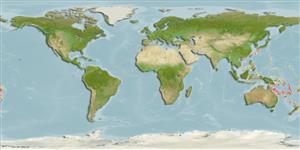>
Anguilliformes (Eels and morays) >
Chlopsidae (False morays)
Etymology: Chlopsis: Greek, chloea = green + Greek, opsis = appearance (Ref. 45335); slusserorum: Named in honor of Marion and Willis Slusser, for their keen interest in natural history and generous support of research and education (Ref. 47953).
Eponymy: Marion Bridgman Slusser (1914–2013) and Willis ‘Bill’ Stanfield Slusser (1915–2010) were enthusiastic amateur naturalists, keen birdwatchers and botanists. [...] (Ref. 128868), visit book page.
More on authors: Tighe & McCosker.
Environment: milieu / climate zone / depth range / distribution range
पारिस्थितिकी
समुद्री बाथीड़िमरसल; गहराई सीमा 366 - 487 m (Ref. 47953). Deep-water
Western Central Pacific: Fiji and the Solomon Islands.
आकार / वज़न / Age
Maturity: Lm ? range ? - ? cm
Max length : 14.1 cm TL पुल्लिंग / अलिंग; (Ref. 47953)
Short description
पहचान कुंजी | आकृति विज्ञान | मौरफोमैटरिक्स
जानवरों की रीड़ का जोड़: 138. Differentiated by its high vertebral count combined with its distinctive pigmentation - light tan, dorso-lateral surface of body overlaid with a series of circa 30-35 dark brown blotches; blotches either do not extend to the dorsal surface (anterior to dorsal origin or near tail) or only weakly extend to the dorsal fin base, which is lightly pigmented for most of its length; blotches do not line up in pairs with blotches on other side of body (Ref. 47953).
Life cycle and mating behavior
परिपक्व अवधि | पुनरुत्पत्ति | मछलीऔ का अंडे देना | अंडे | Fecundity | लार्वा
Tighe, K.A. and J.E. McCosker, 2003. Two new species of the genus Chlopsis (Teleostei: Anguilliformes: Chlopsidae) from the southwestern Pacific. Zootaxa 236:1-8. (Ref. 47953)
IUCN Red List Status (Ref. 130435: Version 2024-2)
Threat to humans
Harmless
Human uses
साधन
Special reports
Download XML
इंटरनेट स्रोत
Estimates based on models
Preferred temperature (Ref.
123201): 7 - 14.2, mean 11.7 °C (based on 20 cells).
Phylogenetic diversity index (Ref.
82804): PD
50 = 0.5002 [Uniqueness, from 0.5 = low to 2.0 = high].
Bayesian length-weight: a=0.00102 (0.00046 - 0.00225), b=3.06 (2.88 - 3.24), in cm total length, based on all LWR estimates for this body shape (Ref.
93245).
Trophic level (Ref.
69278): 3.7 ±0.6 se; based on size and trophs of closest relatives
Fishing Vulnerability (Ref.
59153): Low vulnerability (10 of 100).
